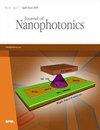Numerical analysis of the propagation modes of photo-switching PDMS-arylazopyrazole optical waveguide and thin-film spectroscopic characterization
IF 1.1
4区 物理与天体物理
Q4 NANOSCIENCE & NANOTECHNOLOGY
引用次数: 0
Abstract
A new light-responsive arylazopyrazole (AAP) containing a polymer matrix thin film is fabricated by spin-coating different concentrations of the AAP azo dye into the polydimethylsiloxane (PDMS) polymer at 150°C. The new AAP molecular switch was also used to fabricate a solid-state PDMS-AAP waveguide by contact lithography and soft replica modeling methods in the micrometer scale. The refractive index of the spin-coated photoswitchable material can be modulated via the reversible trans-to-cis photoisomerization behavior of the AAP unit using different concentrations. When 0.01 M solution of the AAP unit was used, the refractive of the composite was 2.32 in the trans state and dropped to 1.85 in the cis state in the operating wavelength of 340 nm. At higher concentrations of 0.020 and 0.03 M, a wide refractive index tuning is achieved under the same wavelength. In 0.030 M, the refractive index was 2.65 for the trans state and 2.0 for the cis state. The results suggest that the increase in refractive index tuning is related to the concentration of the AAP unit of the composite film. Theoretically, the spectral properties of the composite film are also simulated with two methods: (1) the Maxwell equations and (2) the frequency dependent finite element, showing excellent agreement for the different propagation modes of the proposed waveguide for regulated signals of 365/525 nm wavelengths. Furthermore, the photoisomerization of the PDMS-AAP thin film is analyzed with UV–vis spectroscopy to demonstrate the isomerization responses of the AAP moiety in the solid state. In addition, preliminary photomechanical actuation properties of the composite film have been investigated. The PDMS-AAP waveguide described provides a new approach for optically tunable photonics applications in the UV–visible region.光开关pdms -芳基唑光波导传输模式的数值分析及薄膜光谱表征
在150℃下,将不同浓度的AAP偶氮染料自旋涂覆在聚二甲基硅氧烷(PDMS)聚合物上,制备了一种新型的光响应性芳唑吡唑(AAP)聚合物基质薄膜。利用新型AAP分子开关,采用接触光刻和软复制建模的方法,在微米尺度上制备了固态PDMS-AAP波导。通过不同浓度的AAP单元的可逆反-顺光异构行为,可以调制自旋涂层光开关材料的折射率。当使用0.01 M的AAP单元溶液时,在340 nm工作波长下,复合材料的反式折射率为2.32,顺式折射率为1.85。在0.020和0.03 M的较高浓度下,在相同波长下实现了较宽的折射率调谐。在0.030 M时,反态折射率为2.65,顺态折射率为2.0。结果表明,折射率调谐的增加与复合膜中AAP单元的浓度有关。从理论上讲,复合薄膜的光谱特性也用两种方法(1)麦克斯韦方程和(2)频率相关有限元进行了模拟,结果表明,对于365/525 nm波长的调节信号,所提出的波导的不同传播模式具有很好的一致性。此外,利用紫外-可见光谱分析了PDMS-AAP薄膜的光异构化反应,以证明AAP部分在固态下的异构化反应。此外,还对复合膜的光电致动性能进行了初步研究。所描述的PDMS-AAP波导为光可调谐光子学在紫外可见区的应用提供了一种新的途径。
本文章由计算机程序翻译,如有差异,请以英文原文为准。
求助全文
约1分钟内获得全文
求助全文
来源期刊

Journal of Nanophotonics
工程技术-光学
CiteScore
2.60
自引率
6.70%
发文量
42
审稿时长
3 months
期刊介绍:
The Journal of Nanophotonics publishes peer-reviewed papers focusing on the fabrication and application of nanostructures that facilitate the generation, propagation, manipulation, and detection of light from the infrared to the ultraviolet regimes.
 求助内容:
求助内容: 应助结果提醒方式:
应助结果提醒方式:


